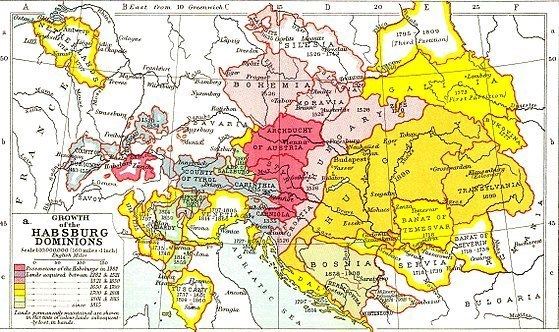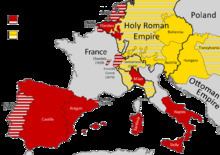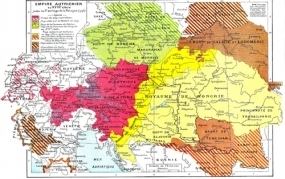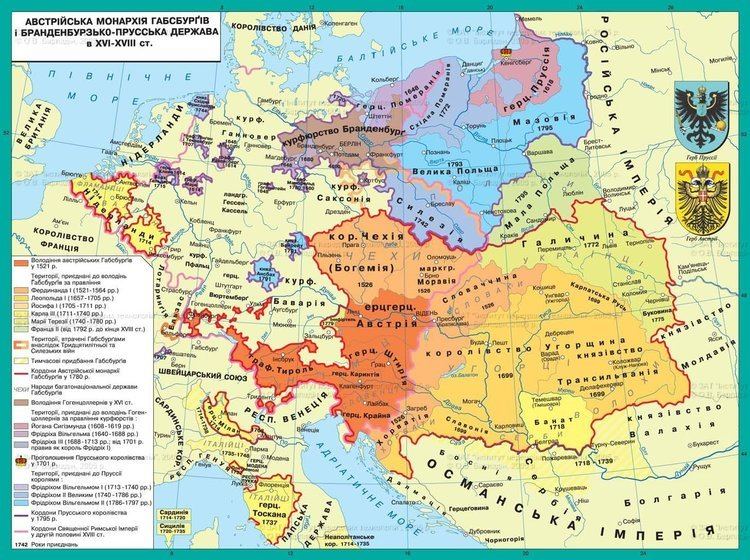Date dissolved 1804 | Founded 1526 | |
 | ||
Languages Official languagesLatin, GermanOther languagesHungarian, Czech, Croatian, Romanian, Slovak, Slovene, Dutch, Italian, Polish, Ruthenian, Serbian, French Religion Official religionRoman CatholicRecognized religionsCalvinism, Lutheranism, Orthodox Christianity, Judaism, Utraquism | ||
Habsburg monarchy
The Habsburg Monarchy (German: Habsburgermonarchie) or Empire, occasionally also styled as the Danubian Monarchy (Donaumonarchie), is an unofficial appellation among historians for the countries and provinces that were ruled by the junior Austrian branch of the House of Habsburg between 1521 and 1780 and then by the successor branch of Habsburg-Lorraine until 1918. The Monarchy was a composite state composed of territories within and outside the Holy Roman Empire, united only in the person of the Monarch. The dynastic capital was Vienna, except from 1583 to 1611, when it was moved to Prague. From 1804 to 1867 the Habsburg Monarchy was formally unified as the Austrian Empire, and from 1867 to 1918 as the Austro-Hungarian Empire.
Contents
- Habsburg monarchy
- The great war s forgotten realm revisiting the habsburg monarchy s first world war
- Origins and expansion
- Terminology
- Territories
- Characteristics
- Habsburg territories outside the Habsburg Monarchy
- History
- Habsburg
- Habsburg Lorraine
- Family tree
- In literature
- References

The head of the Austrian branch of the House of Habsburg was often elected Holy Roman Emperor: from 1415 until the Empire's dissolution in 1806, Charles VII of Bavaria (1742-1745) was the only Holy Roman Emperor who was not Habsburg ruler of Austria. The two entities were never coterminous, as the Habsburg Monarchy covered many lands beyond the Holy Roman Empire, and most of the Empire was ruled by other dynasties.

This Austrian Habsburg Monarchy must not be confused with the House of Habsburg, existing since the 11th century, whose vast domains were split up in 1521 between this 'junior' Austrian branch and the 'senior' Spanish branch.

The great war s forgotten realm revisiting the habsburg monarchy s first world war
Origins and expansion

The Habsburg family originated with the Habsburg Castle in modern Switzerland, and after 1279 came to rule in Austria ("the Habsburg Hereditary Lands"). The Habsburg family grew to European prominence with the marriage and adoption treaty by Emperor Maximilian I at the First Congress of Vienna in 1515, and the subsequent death of adopted Louis II of Hungary and Bohemia in 1526.
Following the death of Louis II of Hungary and Bohemia in the Battle of Mohács against the Turks, his brother-in-law Archduke Ferdinand of Austria was elected the next King of Bohemia and Hungary
Terminology
Names of the territory that (with some exceptions) finally became Austria-Hungary:
The Hungarian parts of the Empire were called "Lands of the Holy Hungarian Crown of Saint Stephen" or "Lands of Holy (St.) Stephen's Crown" (Länder der Heiligen Stephans Krone). The Bohemian (Czech) Lands were called "Lands of the St. Wenceslaus' Crown" (Länder der Wenzels-Krone).
Names of some smaller territories:
In a wider sense the Lands of the Bohemian Crown were also included in (from 1526; definitely from 1620/27) the Hereditary lands. The term was replaced by the term "Crownlands" (see above) in the 1849 March Constitution, but it was also used afterwards.
The Erblande also included lots of small and smallest territories that were principalities, duchies or counties etc. some of them can namely be found in the reigning titles of the Habsburg monarchs like Graf (Earl/Count of) von Tyrol etc.
Territories
The territories ruled by the branch changed over the centuries, but the core always consisted of four blocs:
Over the course of its history, other lands were, at times, under Austrian Habsburg rule (some of these territories were secundogenitures, i.e. ruled by other lines of Habsburg dynasty):
The boundaries of some of these territories varied over the period indicated, and others were ruled by a subordinate (secundogeniture) Habsburg line. The Habsburgs also held the title of Holy Roman Emperor between 1438 and 1740, and again from 1745 to 1806.
Characteristics
Within the Habsburg Monarchy, each province was governed according to its own particular customs. Until the mid 17th century, not all of the provinces were even necessarily ruled by the same person—junior members of the family often ruled portions of the Hereditary Lands as private apanages. Serious attempts at centralization began under Maria Theresa and especially her son Joseph II in the mid to late 18th century, but many of these were abandoned following large scale resistance to Joseph's more radical reform attempts, although a more cautious policy of centralization continued during the revolutionary period and the long Metternichian period which followed.
An even greater attempt at centralization began in 1849 following the suppression of the various revolutions of 1848. For the first time, ministers tried to transform the monarchy into a centralized bureaucratic state ruled from Vienna. The Kingdom of Hungary, in particular, ceased to exist as a separate entity, being divided into a series of districts. Following the Habsburg defeats in the Wars of 1859 and 1866, this policy was abandoned, and after several years of experimentation in the early 1860s, the famous Austro-Hungarian Compromise of 1867 was arrived at, by which the so-called Dual Monarchy of Austria-Hungary was set up. In this system, the Kingdom of Hungary was given sovereignty and a parliament, with only a personal union and a joint foreign and military policy connecting it to the other Habsburg lands. Although the non-Hungarian Habsburg lands, often, but erroneously, referred to as "Austria," received their own central parliament (the Reichsrat, or Imperial Council) and ministries, as their official name – the "Kingdoms and Lands Represented in the Imperial Council" – shows that they remained something less than a genuine unitary state. When Bosnia and Herzegovina was annexed (after a long period of occupation and administration), it was not incorporated into either half of the monarchy. Instead, it was governed by the joint Ministry of Finance.
Austria-Hungary collapsed under the weight of the various unsolved ethnic problems that came to a head with its defeat in World War I. In the peace settlement that followed, significant territories were ceded to Romania and Italy, new republics of Austria (the German-Austrian territories of the Hereditary lands) and Hungary (the Magyar core of the old kingdom) were created, and the remainder of the monarchy's territory was shared out among the new states of Poland, Kingdom of Serbs, Croats and Slovenes (later Yugoslavia), and Czechoslovakia.
Habsburg territories outside the Habsburg Monarchy
The Habsburg monarchy should not be confused with various other territories ruled at different times by members of the Habsburg dynasty. The senior Spanish line of the Habsburgs ruled over Habsburg Spain and various other territories from 1516 until it became extinct in 1700. A junior line ruled over Tuscany between 1765 and 1801, and again from 1814 to 1859. While exiled from Tuscany, this line ruled at Salzburg from 1803 to 1805, and in Würzburg from 1805 to 1814. Another line ruled the Duchy of Modena from 1814 to 1859, while Empress Marie Louise, Napoleon's second wife and the daughter of Austrian Emperor Francis, ruled over the Duchy of Parma between 1814 and 1847. Also, the Second Mexican Empire, from 1863 to 1867, was headed by Maximilian I of Mexico, the brother of Emperor Franz Josef of Austria.
History
For a historical account, see:
Habsburg
Habsburg-Lorraine
Family tree
In literature
The most famous memoir on the decline of the Habsburg Empire is Stefan Zweig's The World of Yesterday.
